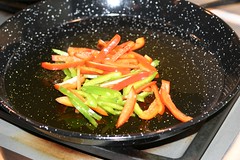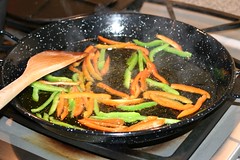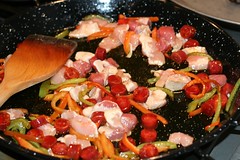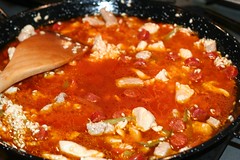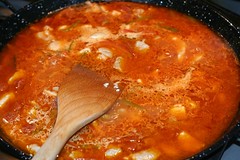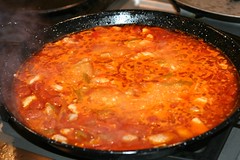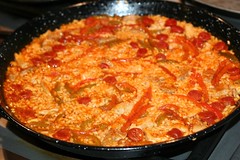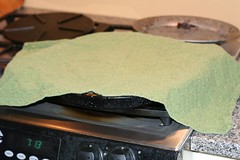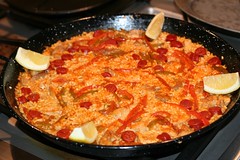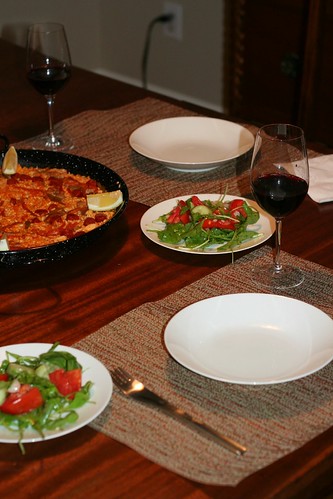
The photo above was taken the weekend before last and shows approximately 200 pounds of beef; 3/4 of a grass-fed Angus steer purchased from Hollins Farms - steaks, roasts, stock bones, assorted parts and over 60 pounds of ground beef. The entire steer provided about 300 pounds of meat that a coworker and I had picked up the day before at a slaughterhouse in Stephens City, Virginia. Fortunately, my coworker took his home with him. We had divided the steer up with three other couples, so by that Sunday my freezer was reduced to about 70 pounds of meat, about a quarter of the original amount.
Hollins Farms lets you get anywhere from a quarter to a full side of the beef. We had purchased a quarter last October and had finished most of it by mid-July, about 90 pounds. As the price of the beef is cheaper when you order a whole steer (3.65 a pound instead of 3.75), we thought we would see if friends of ours would want to go in on a whole. That proved to be no problem, although most of the couples opted for a 1/8 of a share instead of a full quarter. My coworker took 3/8th of the beef. That left us with a quarter. The steer from the quarter share last year weighed around 850 pounds, but the steer this year was more like 650 (the steers are a little smaller than their factory-farmed counterparts), so we got a little less beef with our quarter this year. The s But that's fine: we can always order more.
So now we have 70 pounds of meat to go through over the next few months. Its surprising how little beef we actually end up eating throughout that time. We are certainly not eating any more than when we bought beef at the supermarket, maybe even less. There is a certain challenge to having certain cuts foisted upon you and then trying to figure out what to do with them. When you place an order, you are given a questionnaire to fill out asking if you want some of the more esoteric parts; hearts, liver, tongue, etc. I opted out of the heart, and I thought, the liver, but I ended up with several containers of liver that I will need to contend with. I also took the tongue and am already planning on cooking that this weekend. Alas, I did got get the trendy cheek cut that I was hoping to get. I think that ended up as ground beef.
As for the meat itself, it is absolutely delicious. It is leaner and darker looking than store-bought meat and has a distinctive grass-flavored terroir. Being leaner, I have noticed it cooks a little faster than store-bought meat, so it makes me a lot more vigilant testing for doneness. The ground beef also has lot less fat in it, so I am frequently adding oil when I brown it for recipes.
Really, having all that hamburger is one of the most challenging aspects of the beef share. For whatever reason, I made a whole lot of meat loaf last year. I am going to try and branch out a little more this time around. Ground beef is actually the first thing I cook from this year's share, a ground beef chili pictured below. Chili is yet another dish that people get a little too emotional about. There are definitely those who argue that chili should only be made with chopped pieces of chuck roast or whatever; definitely not with ground beef. I often feel that way about it myself, but not when there is 30 pounds of ground beef in my freezer. Anyway, the story I have always heard about chili is that it was made by cowboys driving cattle. Towards the beginning of the drive, the cowboys used good cuts of meet from cattle they slaughtered. But as the drive started to wind down, the lesser cuts were used and eventually beans were added. I feel like I am working with that principle in reverse by using the ground beef. The good cuts can stay in the freezer while I work my way up to them.
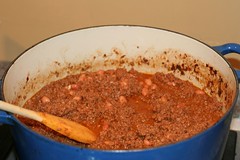
As for the chili itself, I used anchos, cumin, Gebhardt's chili powder (one of the few ConAgra products I will consciously use) and a little Chimayo chili to flavor it - a recipe loosely based on one in "The Complete Meat Coobok" by Bruce Aidells and Denis Kelly. We were only able to eat so much of it, so I went ahead and froze the remaining half for chili dogs or something like that in the future.

